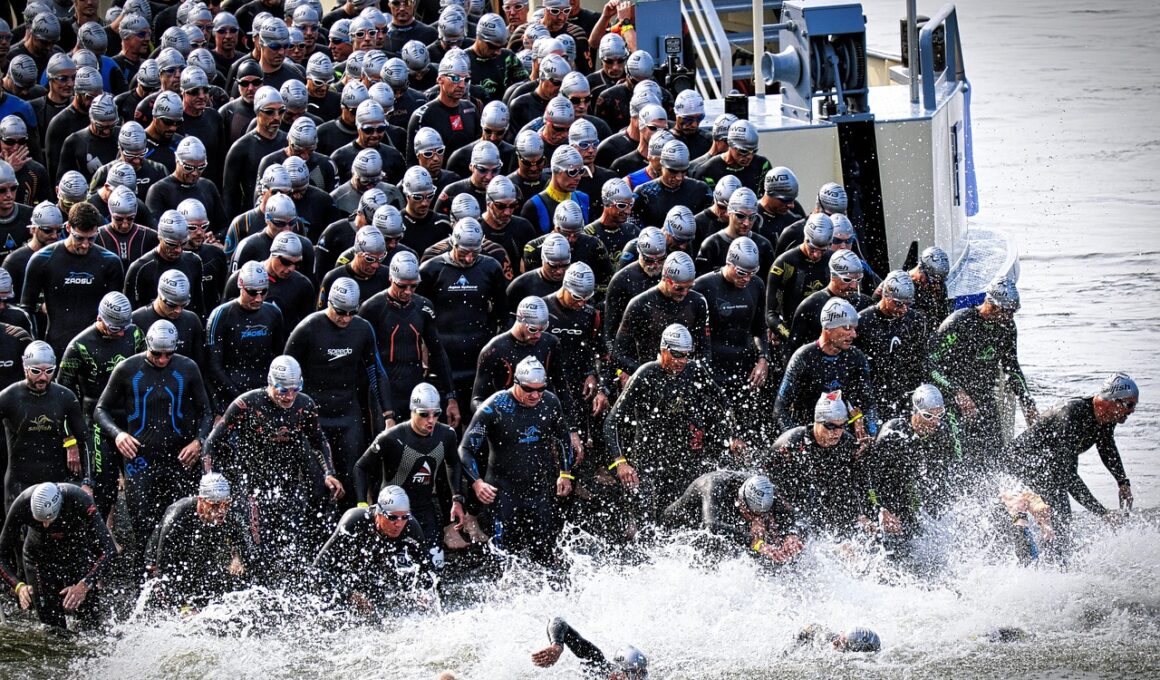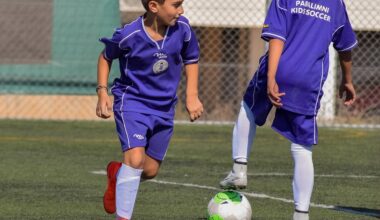Technology Tools to Customize Your Triathlon Training Plan
In today’s competitive world of triathlon, athletes must maximize their training efficiency. Various technology tools can significantly aid in the customization of a triathlon training plan. For example, training apps offer specific workout guidelines tailored to individual fitness levels. These apps allow athletes to track their progress accurately, maintaining overall accountability. Some tools, like GPS watches, track distance, pace, and heart rate, offering real-time analytics to optimize workouts. Athletes can analyze their performance data to make educated adjustments to their training regimen. Additionally, training software packages often utilize advanced algorithms to adjust workouts based on current athlete conditions, fostering personal improvement milestone achievements. Cloud-based platforms enable seamless synchronization across devices, ensuring athletes access to data wherever they go. Wearable devices provide ongoing assessments of training effectiveness and recovery metrics. Furthermore, integrating nutrition tracking apps can solidify a comprehensive approach by harmonizing workouts with dietary needs. These technology tools and devices ultimately enhance the triathlon training experience, empowering athletes to achieve their goals effectively and efficiently.
Wearable Devices for Tracking Progress
Wearable devices have revolutionized triathlon training through meticulous performance monitoring. These high-tech tools help athletes gather essential data, including real-time heart rate, distance, speed, and even sleep quality. By wearing devices such as fitness trackers, athletes can closely observe their physiological responses to various training stimuli. This data-driven approach enables better workout customization, reinforcing strengths and addressing weaknesses. Advanced watches and fitness bands work reliably with smartwatch apps, allowing users to set specific training goals, like target heart rates. They can further use built-in features like interval timers for swimming, biking, and running sessions. A notable example includes multi-sport watches, which transition seamlessly between swimming pools to open water, cycling routes, and running tracks. Equipped with GPS, these devices can record routes, enhancing planning for outdoor workouts. Athletes can also analyze past workouts, identifying trends and patterns that inform future training decisions. Moreover, many wearable devices sync with phone applications, enabling a holistic view of an athlete’s fitness journey. By adopting these innovative devices, triathletes can maintain the motivation needed to push through their rigorous training schedules effectively.
In addition to wearables, smartphone applications have become essential tools in triathlon training. These apps bring various features and functionalities that assist athletes in structuring their daily training. Users can find extensive libraries of pre-set training plans, suitable for different skill levels and goals. Many of them incorporate essential metrics such as speed, pace, and cadence, providing insights that enable users to adjust training routines. For coach-led programs, apps can facilitate communication, allowing athletes to receive real-time feedback on their progress. Moreover, they may offer valuable resources for planning workouts, including customizable durations and intensity levels. The convenience of these apps makes them accessible, as most athletes own smartphones. Leading triathlon apps enable integration with popular outside devices, expanding functionality. For example, syncing GPS watches gives users the ability to create detailed reports. Learning from charted data helps identify successful workout patterns. Additionally, many apps include community features that foster motivation, allowing athletes to connect and challenge each other. This combination simplifies the training journey, ensuring athletes stay engaged and perform consistently, driving them toward their triathlon goals.
Online Coaching Platforms
Online coaching platforms have transformed access to personalized training for triathletes around the world. These platforms offer a diverse range of services, connecting athletes with knowledgeable coaches via digital interfaces. Utilizing video calls, athletes can discuss techniques, strategies, and training adjustments with experienced mentors without geographical restrictions. Many platforms provide tailored training plans in conjunction with coach input, guiding users to reach their specific goals. Features like periodic check-ins and assessments empower athletes to stay accountable during the training process. Through these connections, users can receive feedback on performance and areas of improvement via uploaded training logs. Additionally, communication through platforms often leads to a supportive environment, where peer interactions inspire camaraderie and unity among triathletes. Social features allow users to share accomplishments and strategies, further enhancing the overall experience. Furthermore, the affordability of online coaching makes it accessible for many entry-level triathletes seeking guidance. More advanced athletes can also benefit from specialized coaching in the context of competition preparation. With these platforms, athletes no longer train in isolation, building dynamic communities centered on triathlon achievement and success.
Nutrition tracking applications also play a critical role in effective triathlon training plans. Fueling the body with the right nutrients greatly influences recovery and performance levels. These apps guide athletes in monitoring daily caloric intake, macronutrient ratios, and hydration. They empower users to make informed decisions about food consumption, expanding overall nutritional knowledge. Features include barcode scanning for easy entry, extensive food databases, and recipe suggestions tailored to individual preferences and dietary restrictions. Most applications allow users to set goals according to their training phases, ensuring the right boost during crucial moments. Athletes often find meal-planning utilities helpful, allowing for organized prep sessions, which save valuable time. Synchronizing nutrition apps with wearable devices can provide insights into the relationship between dietary choices and workout performance. Enhanced tracking fosters a comprehensive view of how nutrition influences energy levels before, during, and after triathlons. By understanding the interconnectedness of training and nutrition, athletes can strategically plan fewer injuries and recover more effectively from intense training sessions. Overall, these nutritional tools create a well-rounded approach to achieving optimal performance in triathlon competitions.
Moreover, video analysis software has emerged as a key technology tool in enhancing technique for triathletes. These programs allow athletes to capture their performance visually during swimming, cycling, and running sessions. By analyzing the footage, athletes gain valuable insights into their posture, stroke technique, and efficiency levels. Coaches can then offer constructive feedback, recommending adjustments to optimize performance further. This approach is particularly advantageous for swimming, where technique is vital for efficiency in the water. Many software solutions allow side-by-side comparisons with elite athletes, providing athletes clear visuals of technique improvements. Furthermore, technology platforms such as virtual reality training can simulate race conditions, exposing athletes to support strategizing. By immersing athletes in realistic environments, they can experience various weather conditions, courses, and pacing required during competitions. Ultimately, video analysis enhances self-awareness and fosters an environment of continual growth. Athletes can identify problems before they manifest, ensuring preparedness for race day. These advanced insights promote long-term development, supporting the overarching goal of improved race-day performance through technology.
Leveraging Community Features
Triathletes can further enhance their training by tapping into the community features within various technology tools. Social networking aspects promote camaraderie, share experiences, and offer motivation through collective support. Many training apps and platforms incorporate forums, allowing athletes to exchange tips, training stories, and achievements. This sharing fosters friendships and holds individuals accountable for their training goals. Setting up challenges and competitions helps engage participants and rekindle enthusiasm, reminding individuals of their shared triathlon passion. Additionally, many community features include leaderboards that rank users based on specific metrics, stimulating friendly competition. These elements can push athletes toward new personal bests as they strive to improve their performance. Furthermore, collaboration with fellow triathletes on goal challenges can create effective training groups remotely, leading to beneficial training partnerships. Many platforms offer options to join local clubs and engage in virtual meetups, crucial for improving motivation. By participating in these communities, athletes can find inspiration and tap into a broader knowledge base, further leveraging the available resources. The combined effect of these connections enhances overall training experiences, leading to triumphs in triathlon competitions.
The use of technology tools for triathlon training is continually evolving, incorporating innovations that can streamline the entire training process. With every new feature developed in apps, software, or devices, athletes can enhance their focus on performance improvement. These advancements contribute to tailored experiences, enabling athletes to refine workouts to meet their unique needs more appropriately. The integration of machine learning and artificial intelligence can analyze vast datasets, providing personalized insights and strategies. As competition increases within the industry, tools become more user-friendly, making them accessible to countless athletes. Constantly updated training research allows athletes to stay well-informed about the best practices to improve their performance. With device connectivity, athletes can also synchronize data across multiple platforms, accelerating information sharing. These developments ultimately lead to more comprehensive training plans that are both efficient and adaptable. As technology enhances triathlon training, athletes benefit from more profound insights into their fitness journey and progress. Embracing these tools empowers athletes to connect dots between different training phases, nutrition, and performance recovery. In conclusion, athletes can significantly elevate their chances of success while enjoying the processes available through the latest technology applications.


